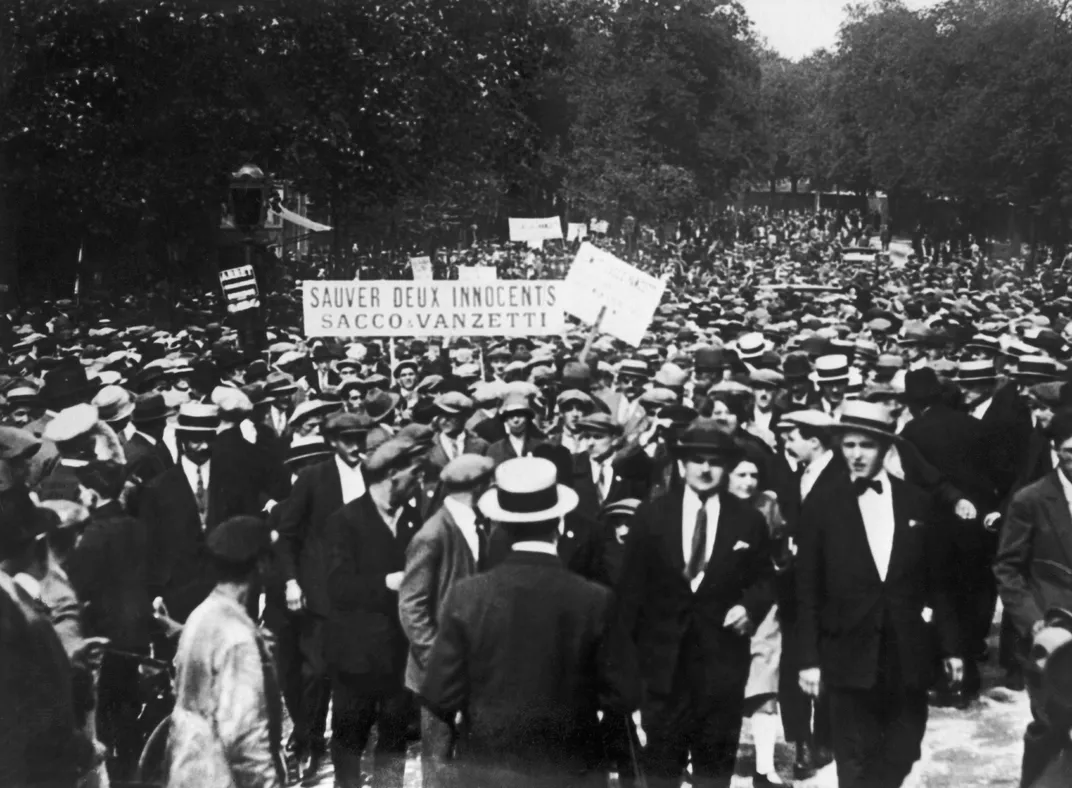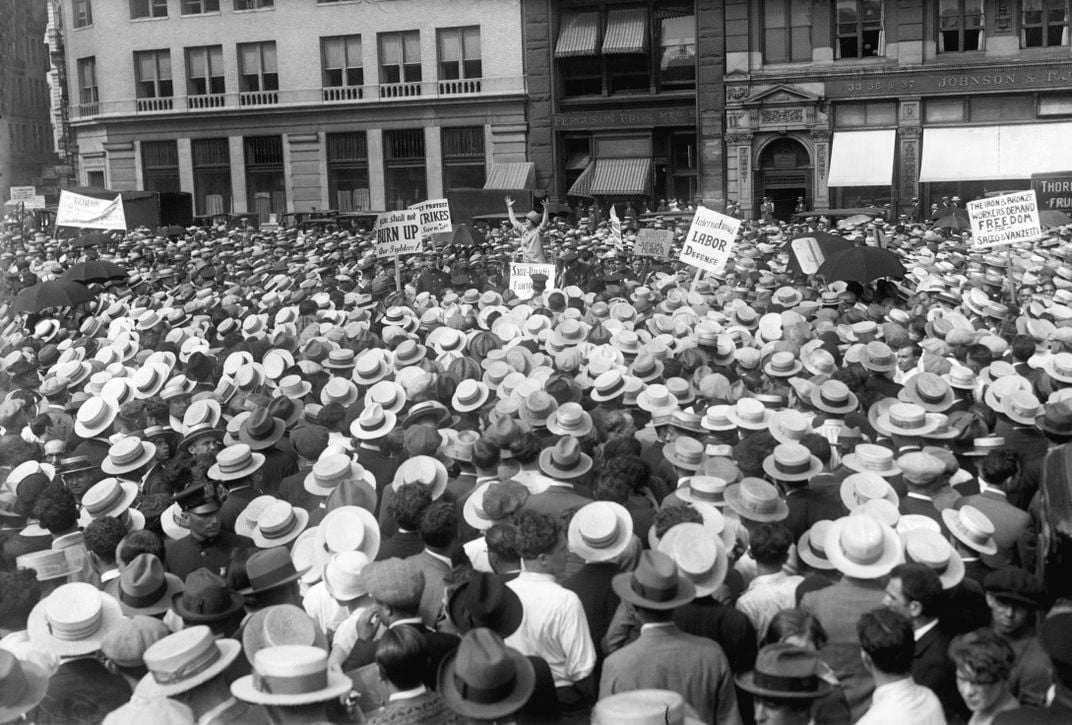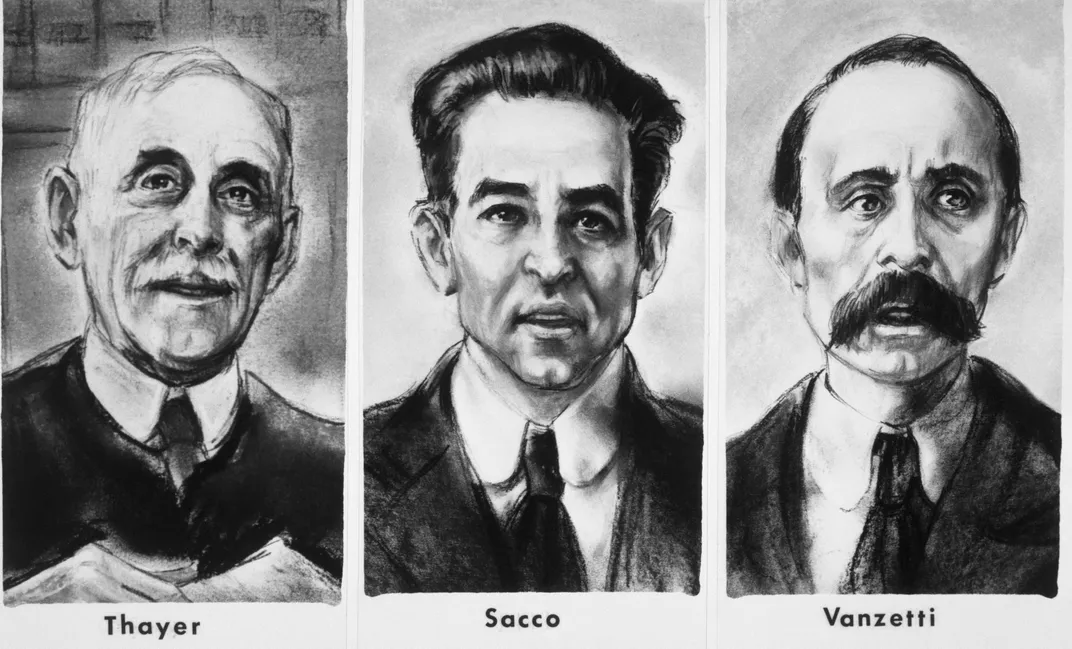Sacco and Vanzetti’s Trial of the Century Exposed Injustice in 1920s America
The pair’s path to becoming media sensations began 100 years ago. To this day the two remain emblems of prejudice in the American justice system
/https://tf-cmsv2-smithsonianmag-media.s3.amazonaws.com/filer/77/f5/77f56aa6-5000-412b-bdc5-8e5b5adf71a8/gettyimages-515162386.jpg)
For six years, starting in 1921, Nicola Sacco and Bartolomeo Vanzetti watched from death row as writers argued for their freedom, politicians debated their case, and radicals held protests and set off bombs in their names. They managed to rally support even from people who initially condemned them. But by May 1927, the pair of leftist ideologues had exhausted their options for an appeal. They had little left ahead of them but the electric chair.
Vanzetti contemplated his impending martyrdom to a visiting reporter. “If it had not been for these things, I might have lived out my life, talking at street corners to scorning men. I might have died, unmarked, unknown, a failure,” he reflected. But now?
Now we are not a failure. This is our career and our triumph. Never in our full life can we hope to do such work for tolerance, for justice, for man’s understanding of man as we now do by dying. Our words, our lives, our pains—nothing! The taking of our lives—lives of a good shoemaker and a poor fish peddler—all! That last moment belongs to us—that agony is our triumph.
It was an unlikely triumph. Sacco and Vanzetti, ages 29 and 31 at the time of their arrest, came from a background more typically conducive to obscurity and suspicion than to sympathetic celebrity: They were radical, working-class Italian immigrants who advocated for the violent overthrow of political and capitalist institutions in the hopes of building, in Sacco’s words, a world of “no government, no police, no judges, no bosses, no authority.” They had dodged the draft to avoid serving in World War I, refusing to fight for a government they believed to be oppressive. Beyond that, the crime for which they were convicted and sentenced to death—two murders committed during a robbery at a shoe factory in Braintree, Massachusetts, in 1920—was not a particularly remarkable one. Even many of their sympathizers acknowledge, to this day, that they may very well have been guilty. But in an era of anti-immigrant, anti-leftist sentiment, their case became an emblem of prejudice in the American justice system—and a rallying point for those who wished to combat it.

In the trial and appeals process that began 100 years ago, the duo’s defense team set out to turn the case into a public sensation, and it undoubtedly succeeded. How much that success truly meant is less apparent. It didn’t save Sacco and Vanzetti; less than four months after Vanzetti spoke about agony and triumph, they were both dead. And the tolerance, the justice, the understanding that he believed himself to be dying for remain, at best, a work in progress..
With their arrest, Sacco and Vanzetti stepped into the center of a firestorm of converging fears, prejudices and swelling radical political power. Nativism and xenophobia were on the rise in the United States. The second iteration of the Ku Klux Klan had formed in 1915, targeting Black Americans, Catholics, and immigrants—including Italians. Anti-immigrant sentiment was gaining traction in more legitimate spaces, too: In 1921 and 1924, while Sacco and Vanzetti were battling the Massachusetts court system, Congress passed restrictive immigration acts intended to stem a post-war influx of “undesirables” and the radical politics they feared might accompany them.
Fear of radicalism “was part and parcel of the xenophobia that was going on at the time,” says Erin Bush, a historian at the University of North Georgia. The Russian Revolution of 1917 had given rise to the first Red Scare, and a slate of assassinations of world leaders since the 1890s—including that of President William McKinley—had further sowed fears of anarchism. In early 1919, a series of bombings enacted by followers of the Italian anarchist Luigi Galleani against prominent American politicians and capitalists “put the violence on the front page,” Bush says, making anarchism feel all the more like “a palpable threat to people.”
Sacco and Vanzetti—themselves suspected Galleanists—had met in 1916 at a factory strike Vanzetti helped organize. Over the following years, they were united by their advocacy for workers and their opposition to World War I; they even fled to Mexico together in 1917 to escape the draft. They were arrested for the robbery and murders in Braintree—which police believed were carried out to fund the anarchist groups ongoing efforts to foment revolution— in May 1920. They entered an American justice system that had spent the attacks’ aftermath pursuing and prosecuting leftist leaders, with a particular focus on Italian anarchists not unlike themselves.
Details about Sacco and Vanzetti immediately began to filter into the news: descriptions of the evidence that had led the police to them and, not far behind, the first inklings of their backgrounds and political leanings. “Alleged Red Literature In Vanzetti’s Room,” declared a Boston Globe headline the week of the arrest. “During the war he was in the last draft and left town,” the article observed.
“Chief of Police Murphy of Milford has identified Saco [sic] as one of the agitators in an attempted industrial disturbance in Milford three years ago,” another Globe article read. “He was arrested and paid a fine. It is also said that Saco was included in the draft and disappeared before he was called.”
The case itself, as described in these early accounts, seemed straightforward. Reportedly, multiple witnesses could identify both Sacco and Vanzetti. Police had found them in possession of weapons, and a number of local officers—cited by name in the papers—gave every sense that they were confident of the culprits’ identities.
Maybe for that reason, the case received only limited press during the initial trial, and almost all of that within Boston. But as they fought to overturn the conviction the defense team worked to change that—and did. Vanzetti’s attorney, Fred Moore, was himself an anarchist and began publicly arguing that the two men had been unfairly prosecuted because of their political beliefs. He dispatched a member of his staff to Europe to spread word among communist parties there and reached out to the newly established American Civil Liberties Union (ACLU).

The Sacco-Vanzetti Defense Committee, formed in the days after the pair’s arrest, sought to raise awareness through the media. At the time, “there were dozens of communist foreign-language newspapers in the United States,” says Michael Topp, a historian at the University of Texas, El Paso, and the author of The Sacco and Vanzetti Case: A Brief History With Documents. “In the Italian language press, especially in the left press in the United States, there were relentless advocates for Sacco and Vanzetti.”
Left-leaning magazines, such as the Nation and the New Republic, also “tended to be sympathetic,” Topp says, while partisan newspapers on the other side of the aisle, especially in the Boston area, pushed for conviction.
The committee submitted articles to the New Republic and labor union publications to drum up awareness among audiences already predisposed to be supportive, in addition to publishing and distributing its own pamphlets, newsletters and bulletins. Photos of Sacco and Vanzetti were sent everywhere. Over time, the letters the accused wrote from behind bars were also publicized.
“They wanted the case to be a touchpoint,” Bush says. “They wanted to be sure the public saw them, they wanted to make sure the public heard them, and they wanted to make sure that they put international pressure on the Massachusetts court.”
Beyond the state of global politics and Sacco and Vanzetti’s eloquence, the details of the case itself—and the story they told about the American justice system—were essential to that public appeal. What appeared in initial newspaper accounts to be a fairly open-and-shut affair became, with time and scrutiny, much less solid. Prosecution witnesses recanted or contradicted their own testimony; the jury foreman was accused of making prejudicial statements before the trial; and, in 1925, four years after Sacco and Vanzetti were convicted, another man came forward to confess to the crimes and assert the men’s innocence.
Then there was the matter of the judge, Webster Thayer, whose behavior both in and out of the courtroom drew accusations of bias. He clashed repeatedly with Moore, at one point saying in front of journalists, “No long-haired anarchist from California can run this court!” He also referred to Sacco and Vanzetti as “Bolsheviki”, a reference to the Russian revolutionaries, and once, a Massachusetts lawyer revealed, as “anarchist bastards.” A friend alleged that before the trial began, Thayer had said he would “get them good and proper” and “get those guys hanged.” Incredibly, after presiding over the first trial, Thayer also ruled on several motions for retrial in the case.

The mounting evidence of prejudice, and the erosion of the prosecution’s case, fueled a massive outcry in the public and the press. Newspapers which had earlier printed support for the original decision—like the New York Times—or even pushed for conviction—like the conservative Boston Herald—published editorials reconsidering those positions.
“We do not know whether these men are guilty or not,” the Herald’s Pulitzer Prize–winning 1926 reversal read. “We have no sympathy with the half-baked views which they profess. But, as months have merged into years, and the great debate over this case has continued, our doubts have solidified slowly into convictions.”
A who’s who of prominent figures from different walks of life expressed support for Sacco and Vanzetti either publicly or privately. Writers Dorothy Parker and Edna St. Vincent Millay showed up to demonstrations; Benito Mussolini, then prime minister of Italy, explored potential avenues for requesting a commutation of the sentence. Various others, from Albert Einstein to George Bernard Shaw to Marie Curie, signed petitions directed toward Massachusetts Governor Alvan T. Fuller or U.S. President Calvin Coolidge.
Leftist groups orchestrated their own shows of support, ranging from a nationwide walkout organized by the Industrial Workers of the World labor union to bombings at the American embassies in Paris and Buenos Aires to a thwarted attempt at the embassy in Lisbon.
The pressure on Fuller was great enough to prompt him, in 1927, to appoint an advisory committee to review the case and initiate his own investigation. But Topp notes that these efforts, too, showed signs of bias. “They both basically ended up just justifying the decision that had been made,” he says. “And then after that committee, and after the governor rendered his verdict, all of the state institutions and newspapers fell back in line.”
Sacco and Vanzetti were executed soon afterward. But reactions to the case, both political and scholarly, literary and violent, have far outlived them. “I don’t think Sacco and Vanzetti had a lasting impact in terms of their own personal political philosophy,” Topp says. Instead, he asserts, its legacy lies more in what it showed about the legal process: “It was another moment where the arbitrariness and the oppressive nature of the U.S. judicial system was exposed.”
In that area, the case and the uproar it fomented did bring about real change—to a degree. It motivated the Massachusetts Judicial Council to propose a series of reforms making it easier to secure a new trial and harder for a single judge to exert so much control over a future case. Though it took more than a decade, these proposals were eventually adopted in the late 1930s.
But the larger prejudice the case demonstrated—that, in Topp’s words, “who you are and, in this instance, what you believe, has an enormous amount to do with how you’re treated by the judicial system”—remains endemic. Topp draws parallels between Sacco and Vanzetti’s treatment and that of Mumia Abu-Jamal, an activist for the black separatist MOVE organization, in Philadelphia in the 1980s, and of Black Americans by police officers into the present day.
“We’re well past the moment of the Progressive Era, that politics of revelation, where there’s a belief that if you expose wrongdoing then immediately it will be addressed and remedied,” Topp observes.
As the Sacco and Vanzetti case and its continued resonance a century later demonstrate, he asserts, “We don’t live in that kind of a world. We live in a world where, when injustice is exposed, there are moments when injustices can be righted. But there are also moments that we see to this day when, after that exposure, institutions of power will protect themselves.”